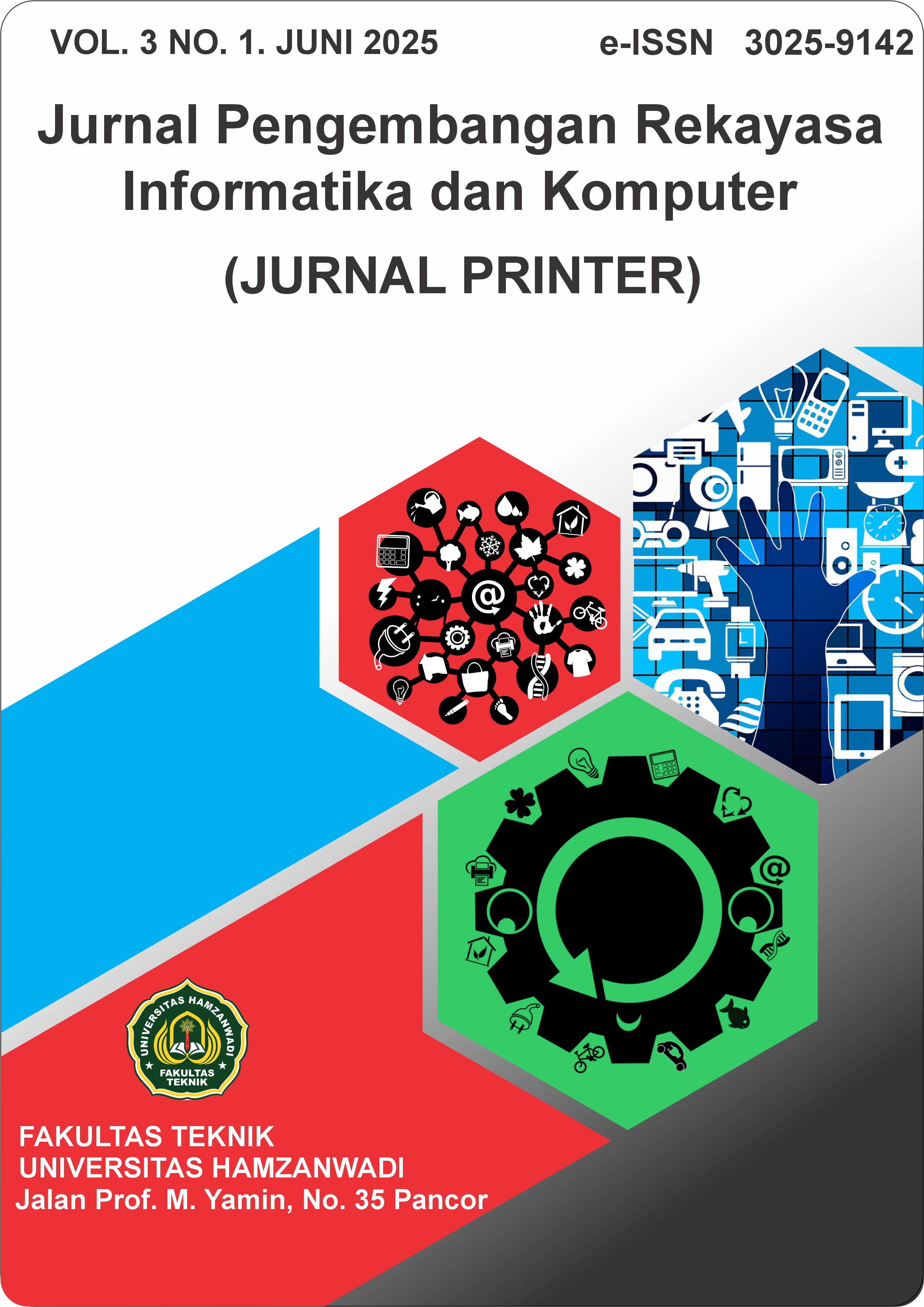Analisis Faktor Keterlambatan Pemasangan Meter Baru Menggunakan Metode Decision Tree Pada PT PLN Unit Layanan Pelanggan Daerah Pringgabaya Lombok Timur
DOI:
https://doi.org/10.29408/jprinter.v3i1.31058Keywords:
decision tree, classification, serviceAbstract
PT. PLN (Persero) ULP Pringgabaya is one of the units established by PT PLN to be able to provide direct services to the community in areas with smaller coverage. However, the use of electricity by the community has increased the demand for the installation of new meters. This study aims to analyze the causes of delays in the installation of new meters. In order to classify the highest causes of installation delays, the Decision Tree method is used. The number of data sets used is 700 data with attributes, such as the distance of the location to the PLN network (Meter), electric voltage (Volt), customer contact, SLO (Certificate of Operational Worthiness), Installation and Installation Status. From the calculation results, the acquisition includes Distance <= 37 M from the PLN network, voltage >= 220 Volts, inactive contacts, old SLOs issued, and uninstalled installations. Testing was carried out 10 times using cross validation with 100% accuracy results with an AUC value of 1.00, which means that the use of the decision tree algorithm can be utilized in determining the classification of the causes of delays in the installation of new meters at PT PLN ULP (Customer Service Unit) Pringgabaya. So it can be concluded that the cause of the delay in the installation of new meters at PT PLN ULP (Customer Service Unit) Pringgabaya is not caused by service criteria but is influenced by distance, voltage, and new customer contacts.
References
[1] A. M. Nur, M. F. Wazdi, B. Harianto, and M. F. Zaini, “Implementation of Naive Bayes Algorithm in Analyzing Acceptance of Poor Student Assistance,” in Journal of Physics: Conference Series, Institute of Physics Publishing, Jul. 2020. doi: 10.1088/1742-6596/1539/1/012018.
[2] B. Andriska, C. Permana, M. Sadali, and R. Ahmad, “Penerapan Model Decision Tree Menggunakan Python Untuk Prediksi Faktor Dominan Penyebab Penyakit Stroke,” Jurnal Informatika dan Teknologi, vol. 7, no. 1, p. 23, 2024, doi: 10.29408/jit.v7i1.23232.
[3] Y. Yahya, N. Nurhidayati, and A. Suherman, “Prediksi Tingkat Kesehatan Masyakarat Berdasarkan Penggunaan Alat Kontrasepsi Menggunakan Algoritma Random Forest,” Infotek : Jurnal Informatika dan Teknologi, vol. 7, no. 1, pp. 185–194, Jan. 2024, doi: 10.29408/jit.v7i1.24321.
[4] M. Terhadap Layanan Akademik Dan Kemahasiswaan, R. Kurniah, D. Yunika Surya Putra, E. Diana, P. Studi Informatika, and U. ProfDrHazairin, “Penerapan Data Mining Decission Tree Algoritma C4.5 Untuk Mengetahui Tingkat Kepuasan,” Jurnal Informatika dan Teknologi, vol. 5, no. 2, p. 316, 2022, doi: 10.29408/jit.v5i2.5910.
[5] D. Kabupaten, L. Timur Mahfuz, A. Muliawan Nur, and L. M. Samsu, “Penerapan Algoritma C4.5 Dalam Mengklasifikasi Status Gizi Balita Pada Posyandu Desa Dames,” Jurnal Informatika dan Teknologi, vol. 5, no. 1, p. 72, 2022, doi: 10.29408/jit.v5i1.4414.
[6] H. A. S. Yupi Kuspandi Putra, “Komparasi Algoritma C4.5 Dan C4.5 Berbasis Pso Untuk Prediksi Jumlah Penggunaan BBM Perbulan Pada Kantor Dinas Lingkungan Hidup Dan Kebersihan Kabupaten Lombok Timur,” 2019.
[7] “Penerapan Data Mining dalam Mengelompokkan Jumlah Kematian Penderita COVID-19 Berdasarkan Negara di Benua Asia”, doi: 10.31294/p.v21i2.
[8] G. G. I. (2021) Gunawan, “Analisis Perilaku Pengguna Internet Dengan Data Mining Metode K-Means,” 2021.
[9] M. Romzi and B. Kurniawan, “Pembelajaran Pemrograman Python Dengan Pendekatan Logika Algoritma,” 2020.
[10] G. I. E. Soen, M. Marlina, and R. Renny, “Implementasi Cloud Computing dengan Google Colaboratory pada Aplikasi Pengolah Data Zoom Participants,” JITU : Journal Informatic Technology And Communication, vol. 6, no. 1, pp. 24–30, Jun. 2022, doi: 10.36596/jitu.v6i1.781.
[11] E. Nofiyanti and E. M. Oki Nur Haryanto, “Analisis Sentimen terhadap Penanggulangan Bencana di Indonesia,” Jurnal Ilmiah SINUS, vol. 19, no. 2, p. 17, Jul. 2021, doi: 10.30646/sinus.v19i2.563.
[12] L. N. Fadhila, I. Kadek, and D. Nuryana, “Teks Ringkas Otomatis pada Portal Berita CNN Indonesia Menggunakan Algoritma Textrank,” 2024.
[13] A. Thariq and R. Y. Bakti, “Sistem Deteksi Masker dengan Metode Haar Cascade pada Era New Normal COVID-19,” Jurnal Sistem dan Teknologi Informasi (Justin), vol. 9, no. 2, p. 241, Apr. 2021, doi: 10.26418/justin.v9i2.44309.
[14] L. Rahma, H. Syaputra, A. H. Mirza, and S. D. Purnamasari, “Objek Deteksi Makanan Khas Palembang Menggunakan Algoritma YOLO (You Only Look Once),” 2021.
[15] S. Bahri and A. Lubis, “METODE KLASIFIKASI DECISION TREE UNTUK MEMPREDIKSI JUARA ENGLISH PREMIER LEAGUE,” vol. 2, no. 1, 2020.
[16] K. Algoritma Nonparametrik untuk Klasifikasi Citra Wajah Berdasarkan Suku di, S. Hartono, H. Sujaini, and A. Perwitasari, “JEPIN (Jurnal Edukasi dan Penelitian Informatika)”.
[17] P. B. N. Setio, D. R. S. Saputro, and B. Winarno, “PRISMA, Prosiding Seminar Nasional Matematika Klasifikasi dengan Pohon Keputusan Berbasis Algoritme C4.5,” vol. 3, pp. 64–71, 2020, [Online]. Available: https://journal.unnes.ac.id/sju/index.php/prisma/
[18] I. Teknik, P. Peminatan, J. Siswa, and M. Algoritma, “Indra Gunawan 3) , Iin Parlina 4) , Irawan 5) 1) 3) 4) 5) Teknik Informatika,” vol. 2, no. 2, pp. 1–5, 2021, [Online]. Available: http://creativecommons.org/licences/by/4.0/
[19] Y. Yahya, N. Nurhidayati, and A. Suherman, “Prediksi Tingkat Kesehatan Masyakarat Berdasarkan Penggunaan Alat Kontrasepsi Menggunakan Algoritma Random Forest,” Infotek : Jurnal Informatika dan Teknologi, vol. 7, no. 1, pp. 185–194, Jan. 2024, doi: 10.29408/jit.v7i1.24321.
Downloads
Published
Issue
Section
License
Copyright (c) 2025 Jurnal PRINTER: Jurnal Pengembangan Rekayasa Informatika dan Komputer

This work is licensed under a Creative Commons Attribution-ShareAlike 4.0 International License.





